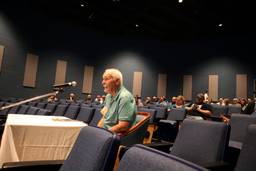As Election Day approaches, the staff at In These Times thought it might be interesting to do a round-up of some of our bigger election-related stories from the past year. ITT Senior Editor Christopher Hayes got the ball rolling last December with a cover story titled “Who is Sherrod Brown?” As Brown appears all but a shoo-in to become Ohio’s junior senator tomorrow, that’s a question you’ll want to know the answer to.
In March, Sam Seder interviewed Democratic Senate candidate Ned Lamont, back when he was little more than a twinkle in the netroots’ eye. As he and Joe Lieberman head to the finish line of a hard-fought race in Connecticut, check out “Why Ned Lamont Is A Democrat.”
There’s been a lot of talk lately about Democrats taking over one or both houses of Congress. But back in April, ITT Contributing Editor Hans Johnson had already seen the writing on the wall, noting that the “GOP [Got] Trashed in Special Elections.”
In October, ITT Associate Editor Phoebe Connelly examined several races for secretary of state. Learn why progressives are putting so much energy into these races by reading “SOSing the Vote.”
If the Democrats do manage to win one or both houses, there will be a lot of mainstream prognosticating about how they managed the feat. Anything that argues counter to Tom Schaller’s compelling October examination of “Where the Seats Are” can be safely dismissed as non-reality based.
Of course, anyone who thinks that if they win the Democrats will have it easy hasn’t read ITT Senior Editor David Sirota. As he pointed out in October, win or lose, 2007 looks likely to be a year of “Dueling Democrats.”
Of course, as educated and informed as you may be, democracy, or what’s left of it, can still be confusing. So here’s a citizen-friendly guide to some of the most useful information on the Web to help you feel confidence in, if not who you vote for, than at least why.
For an incredibly comprehensive guide to everything from state by state ID requirements to polling place locations to candidate information, check out Vote411.org, launched by the League of Women Voters. The site, which calls itself a “one-stop-shop’ for election related information,” is also superbly organized and user-friendly. For more localized candidate and ballot-initiative information, The League of Young Voter’s theballot.org is easy to navigate, not to mention loaded with creative catchphrases and contagious enthusiasm. The only catch is that the voters’ guides are limited to a handful of areas, but, if you’re truly committed to participatory democracy, the site does allow you to create your own local guide. Plus, we have to give it to up to the League for so effectively confronting young voter disenfranchisement.
Thinking about voting for the incumbent or a previously elected official? Find out how they really feel about the issues that matter to you by checking out their voting records. Project Vote Smart not only gives you a by-issue list of legislation and your candidate’s vote, they also provide history, highlights and a synopsis of each piece – just in case you don’t know exactly what the Military Construction Appropriations Act FY2003 (HR 5011) is. The Web site also serves as a type of all-you-can-eat buffet for every candidate and current official. You can also check out the AFL-CIO Web site (and the Washington Post online) for a chronological list of officials’ voting records.
So, now that you’re registered, you know where to vote and you can sing about the issues and initiatives to the tune of the national anthem, become more intimate with your candidates, or at least their bank accounts, with a loving glance over their campaign finance records. The Institute on Money in State Politics allows you to search political contributions by candidate, contributor, or special interest group. They then provide breakdowns by overall top contributors, by top industry contributors, contributions made by economic interest, by geographic location and a contributor sector analysis. For a national perspective, check out opensecrets.org, which, among many other things, presents breakdowns of the ten most expensive House and Senate races, as well as a list of candidates who have raised and spent the most. And if you want to get even more personal, you can look at the list of top self-funders. Opensecrets.org also allows you to search by candidate for an individual report, or by race for “head-to-head comparisons of the candidates in every U.S. House and Senate race this year.”
For protecting the votes, check out Election Protection 365, a project of People for the American Way, which provides information about restrictive registration, intimidation and deceptive practices, voting list purges and felon rights. Clicking any of the aforementioned links will take you to a Wikipedia-style run-down of the issue. EP365 also provides state-specific information such as polling place hours and forms of acceptable ID. Then, to remind you that we are living in a first-world, 21st Century democracy, there is the innovative Video the Vote where anyone with a digital motion camera can sign up to document any “irregularities” at the polls; just in case of highly unlikely scenarios of voter disenfranchisement, or malfunctioning Diebolds, or ballot miscounts – you know, preposterous blunders that only occur in corrupt Third World democracies. Participants can then upload their footage to the Video the Vote Web site for public viewing. Teaming up with Video the Vote and an A-list crew of hip activist organizations, like PunkVoter and the National Hip-Hop Political Convention, is the Ruckus Society. Anyone with a cell phone can sign up to work with Ruckus, who is “combining…direct action expertise with…Cell Phone/Text Message Technology know-how” for rapid response election protection. Participants will receive a call or a text message to alert them to hit the polls in case of, again, those unlikely “irregularities.” And, for good measure, you can also inform the National Association of Secretaries of State of any problems; contact them at nass@sso.org.
Whether or not you take virtual action to ensure a smooth democratic process, you’ll probably want to check the Web for feedback from the self-elected officials of our fourth estate: Bloggers. For up-to-the-minute online discourse through election night try gather.com. The site does not get as much action as more heavily trafficked spots like AlterNet.org and Slate.com, but it does dish up some fresh perspectives and a bit more debate from all sides. If you’re looking for a truly biased, progressive perspective, check out dailykos.com (a straight-up, lefty political rant blog), boingboing.net (a garbage-style site that will surprise you every time), or liberalfeministbias.blogspot.com, which, hopefully, speaks for itself.

I hope you found this article important. Before you leave, I want to ask you to consider supporting our work with a donation. In These Times needs readers like you to help sustain our mission. We don’t depend on—or want—corporate advertising or deep-pocketed billionaires to fund our journalism. We’re supported by you, the reader, so we can focus on covering the issues that matter most to the progressive movement without fear or compromise.
Our work isn’t hidden behind a paywall because of people like you who support our journalism. We want to keep it that way. If you value the work we do and the movements we cover, please consider donating to In These Times.






